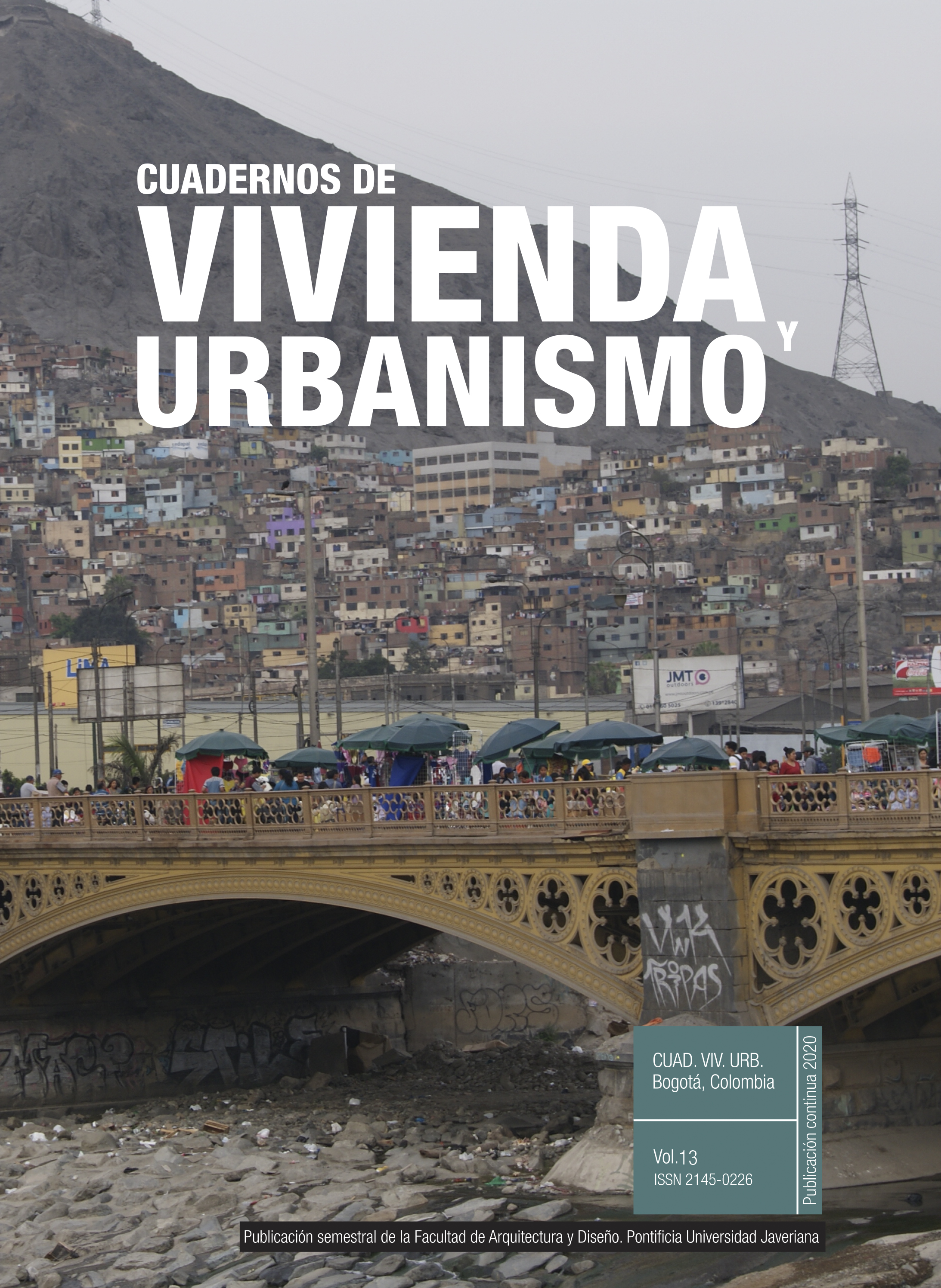Abstract
The proliferation of high-rise residential buildings in the central and pericentral fabric of the Chilean cities is a recent phenomenon and its intensity leads to ask about the effects it has on the urban interaction. This paper explores the records and accounts giving rise to two different narratives of the verticalization phenomenon: a first one articulated around the surveys of building; and a second one based on press releases telling events in high-rise buildings. Both of them result useful to verify how this phenomenon –occurring under the agency of architectural institutions– becomes an urban regime. That is to say, how it translates into regulations to allow producing modes of order for the interaction in the cities.
Boltanski L., y Thévenot L. (2006). On Justification. Economies of Worth. Nueva Jersey: Princeton University Press.
Bowker, G., y Star, S. L. (1999). Sorting Things Out. Classification and Its Consequences. Cambridge: The MIT Press.
Goldthorpe, J. (2017). La sociología como ciencia de la población. Madrid: Alianza Editorial.
Graham, S. (2016). Vertical: The City from Satellites to Bunkers. Nueva York: Verso.
Grubbauer, M. (2010). The High-Rise Office Tower as a Global ‘Type’: Exploring the Architectural World of Getty lmages and Co. En M. Guggenheim y O. Söderström (eds.), Re-shaping Cities. How Global Mobility Transforms Architecture and Urban Form (pp. 63-80). Londres: Routledge.
Guggenheim, M. (2009). Building Memory: Architecture, Networks and Users. Memory Studies, 2(1), 39-53. https://doi.org/10.1177/1750698008097394
Hilberseimer, L. (1999). La arquitectura de la gran ciudad. Barcelona: Editorial Gustavo Gili.
Hommels, A. (2005). Studying Obduracy in the City: Toward a Productive Fusion between Technology Studies and Urban Studies. Science, Technology, & Human Values, 30(3), 323-351. https://doi.org/10.1177/0162243904271759
Ingold, T. (2010). The Textility of Making. Cambridge Journal of Economics, 34(1), 91-102. http://dx.doi.org/10.1093/cje/bep042
Instituto Nacional de Estadísticas (INE). (2006). Manual para el Análisis del Formulario Único de Edificación. Santiago de Chile: INE.
Instituto Nacional de Estadísticas (INE). (2007a). Definición y listado de ciudades de Chile. Santiago de Chile: INE. Recuperado de http://observatoriourbano.minvu.cl/indurb/wp_pre_ciudades.asp?idComciu=0
Instituto Nacional de Estadísticas (INE). (2007b). Metodología Encuesta de Edificación Mensual. Santiago de Chile: INE.
Latour, B. (1987). Science in Action: How to Follow Scientists and Engineers Through Society. Cambridge: Harvard University Press.
Latour, B. (2001). La esperanza de Pandora. Ensayos sobre la realidad de los estudios de la ciencia. Barcelona: Gedisa.
Law, J. (2015). What’s Wrong with a One-World World? Distinktion: Journal of Social Theory, 16(1), 126-139. http://dx.doi.org/10.1080/1600910X.2015.1020066
Law, J., y Mol, A. (2009). El actor-actuado: La oveja de la Cumbria en 2001. Política y Sociedad, 45(3), 75-92. Recuperado de http://revistas.ucm.es/index.php/POSO/article/view/POSO0808330075A
Law, J., y Singleton, V. (2013). ANT and Politics: Working in and on the World. Qualitative Sociology, 36(4), 485-502. https://doi.org/10.1007/s11133-013-9263-7
Le Corbusier. (1985). La ciudad del futuro. Buenos Aires: Ediciones Infinito.
Mahoney, J. (2015). Process Tracing and Historical Explanation. Security Studies, 24(2), 200-218. http://dx.doi.org/10.1080/09636412.2015.1036610
Marín, H., Ruiz-Tagle, J., López-Morales, E., Orozco, H., y Monsalves, S. (2019). Gentrificación, clase y capital cultural: transformaciones económicas y socioculturales en barrios pericentrales de Santiago de Chile. Revista Española de Investigaciones Sociológicas, (166), 107-134. http://dx.doi.org/10.5477/cis/reis.166.107
Martínez, J. P., y López, E. (2018). Massive Housing in Central Neighborhoods: Who Is Responsible for the Excessive Densification? ARQ (Santiago), (98), 144-153. https://dx.doi.org/10.4067/S0717-69962018000100144
Ramos, C. (2018) Dispositivo de evaluación y gubernamentalidad del sistema educacional: entretejimiento de ciencia social y poder. Cinta moebio, (61), 41-55. http://dx.doi.org/10.4067/S0717-554X2018000100041
Star, S. L., y Griesemer, J. R. (1989). Institutional Ecology, ‘Translations’ and Boundary Objects: Amateurs and Professionals in Berkeley’s Museum of Vertebrate Zoology, 1907-39. Social Studies of Science, 19(3), 387-420. https://doi.org/10.1177/030631289019003001
Thévenot, L. (2016). La acción en plural. Una introducción a la sociología pragmática. Buenos Aires: Siglo XXI.
Thompson, J. (2001). El escándalo político: poder y visibilidad en la era de los medios de comunicación. Barcelona: Paidós
Vergara Vidal, J. (2017). Verticalización. La edificación en altura en la Región Metropolitana de Santiago (1990-2014). Revista INVI, 32(90), 9-49. http://dx.doi.org/10.4067/S0718- 83582017000200009
This journal is registered under a Creative Commons Attribution 4.0 International Public License. Thus, this work may be reproduced, distributed, and publicly shared in digital format, as long as the names of the authors and Pontificia Universidad Javeriana are acknowledged. Others are allowed to quote, adapt, transform, auto-archive, republish, and create based on this material, for any purpose (even commercial ones), provided the authorship is duly acknowledged, a link to the original work is provided, and it is specified if changes have been made. Pontificia Universidad Javeriana does not hold the rights of published works and the authors are solely responsible for the contents of their works; they keep the moral, intellectual, privacy, and publicity rights.
Approving the intervention of the work (review, copy-editing, translation, layout) and the following outreach, are granted through an use license and not through an assignment of rights. This means the journal and Pontificia Universidad Javeriana cannot be held responsible for any ethical malpractice by the authors. As a consequence of the protection granted by the use license, the journal is not required to publish recantations or modify information already published, unless the errata stems from the editorial management process. Publishing contents in this journal does not generate royalties for contributors.



